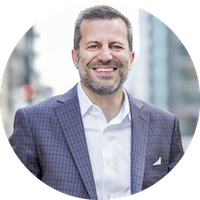Ten words is all it takes for Todd Caponi to know whether a sales email was worth opening. As a former chief revenue officer for PowerReviews, Caponi has been on the receiving end of a lot of emails — often 150 messages a day pushing his inbox to its limits. If a salesperson didn’t provide enough value, be it a survey or a relevant article in the first 10 words of the email preview, Caponi wasn’t going to take the time to read it.
Caponi, who is now a sales coach and author of the book The Transparency Sale, said his experience and approach isn’t unusual. As email automation tools and written communication flood inboxes, it’s harder than ever for a salesperson to stand out, and a strong follow-up strategy is more important than ever.
But what does a successful sales follow up email look like? For starters, it needs to be concise, it needs to be personalized and it needs to provide value beyond the sale, added Nick Casale, director of sales at the direct-mail marketing platform, Sendoso.
Easier said than done.
We spoke with Casale, Caponi and Katie Fudge, account executive at the sales automation company Close, about how to write follow-up emails that grab the customer’s attention and keep the sale moving along — even if they’re not interested at first.
Sales Follow Up Email Tips
- Keep the message concise.
- Provide value beyond summarizing key points from the meeting.
- Don’t focus on yourself. Give the customer information that can help them do their job.
- Don’t overthink the subject line. Keeping it clear and descriptive can make it easier to find later.
- Always include next steps, and be clear about who’s responsible for what.
- Inbox organization is key. Find a strategy to keep track of your follow-up messages.
- Don’t stop following up too soon.
What is your approach to writing a follow-up email after you’ve connected with a customer?

Nick Casale
Director of Sales, Sendoso
A lot of times, a follow-up is your chance to add additional value over what would happen on a phone call. So a great thing to include is lines like, “Hey, based on our conversation,” or “After talking with my team” or “I thought this industry report from Forester was really relevant to some of the challenges that you guys were seeing in the market as well.” You want to be constantly adding value and avoid sending an email for the sake of sending an email.
Don’t be afraid to personalize it. Especially now, saying something like “I hope you’re staying safe” is valuable. I was on a call the other day where someone’s kids were in the background jumping around on the bed. So we sent a $15 Amazon gift card and a message saying that I hoped he could rent a video for the kids, and find some time to tackle his projects. Those are all helpful things that help build that relationship and make a human connection.

Todd Caponi
Sales Coach and Speaker, Author of The Transparency Sale
I’m a huge advocate of what I call mutual decision plans. Your job as a salesperson is to guide them through the buying journey. It’s not to sell them something but to help them make a really good decision. You’re telling them that this is the path we’re going to take, and we’re going to camp here, and then this is where we’re going tomorrow. And you make sure everybody is doing OK. That’s what a guide does, and that’s what a salesperson should do.
Most of our buyers haven’t bought anything like what we’re selling before. If you’ve sold 20 deals, you probably know more about what they need to do to buy the product than they do. So those follow-up emails should take the tone of a guide. It should show what you talked about, a couple of steps that they should consider thinking about. And again, make it personalized. If it’s clearly meant for them and not a form letter, more likely than not, you’re going to get some kind of ping back saying that they’ve read it and appreciate it.

Katie Fudge
Account Executive, Close
I always summarize the meeting. It’s usually just helpful information that they’ve asked for, and then it’s a very easy thing for them to follow up on.
If it’s not related to a meeting, something I learned in my previous job was to take out as many words as I could with it still making sense. I found that that does work, especially if you’re talking to CEOs or people who get hundreds of emails a day. If they see that it’s a lengthy email, they don’t even bother with it. If it’s simple and direct, it’s a lot easier to click on, even if you’re just asking for a “yes” or “no” answer.
When should you be sending your follow-up, and how often should you be emailing?
Casale: Within the same business day is best practice, but I don’t think the first thing the next morning is the end of the world. The one key piece is, if you’re going to commit to a time, you want to stick to it. It’s OK to say, “I’m slammed today, I’ll get that to you first thing in the morning.”
It’s important to commit to a timeline in a way that’s valuable to your contact without over-committing or feeling like you need to rush something to them just for the sake of getting it out the door. It’s better to make sure that a follow-up email is done thoughtfully and adds value, rather than using a template just to get it done quicker.
Fudge: My sales philosophy is you don’t stop following up until they tell you no. I don’t need to continue reaching out to you every day after your trial expired, but I should never stop reaching out to you in some creative way until you say, “Hey, stop emailing me.”
If I have somebody who is deciding now, I send them a follow-up email right away, and then I set a reminder on that email to see if they’ve opened and responded within one or two days. That way, it’s showing up in my inbox and I’m making sure to call or follow up with them. If they’re just exploring and they’re in a contract until the end of June, I send them a follow-up email with a reminder set a month out.
How much information should you be including in your email follow-up?
Casale: Concise is king. If you’re going to talk about a feature, why is that being mentioned? For Sendoso, we can talk about sending door openers to increase your tier-one accounts from “cold” to “sales opportunity.” Adding tangible touch points is good. Part of what you’re doing with a follow-up email is creating mutually agreed upon points, whether it’s business challenges or what’s been discussed. This will be a reference point for both parties.
I have no problem with that being a long follow-up email if you’re delivering an enormous amount of information and value, but each point itself should be very concise. Bullet points help because they give you a pass to use fewer words. The eyes tend to go there. I’m also a fan of using bold to highlight a data point or keyword. You have your opening, your bullets, which is your meat, and then you have your conclusion with your next steps.
Caponi: In those follow-up emails where you’re trying to maybe reignite something or keep the motor running, keep your message short. It should be closer to Twitter-length, versus War and Peace length. Remove those I’s and we’s, and give them something that’s gonna make them smarter about what they do. You should be collecting resources and little stats and data that you can just share with them that makes them smarter about what they do.
What should the subject line include?
Casale: “Sendoso and [company name] Next Steps.” Don’t overthink it. If you think about the number of things that you need to actually assign thought and creativity to in a day, coming up with a catchy subject line for every email will make you go a little crazy. It’s not worth the calories. If you’ve done your job on that phone call, they’re opening the follow-up email, and your subject line isn’t necessarily gonna change that.
There’s also an element of inbox sanity to be able to just search your inbox for those things. I know that I could go back and find an email from a deal I worked two years ago by searching that company name and follow-up.
Fudge: Those are always the toughest. The initial one would just be, “Close and [company].” Subject lines that are relevant to the company will get them to open it, but I like to get goofier as time goes on. Sometimes you can draw them in because it’s unusual. Just make sure you’re not click-baiting them and the email says what you’re talking about. One good subject line that my coworker came up with is, “Radio Silence.” It just lets them know that I’m available for anything they need, but I’m not going to hinder their focus if they’ve already got Close figured out.
Caponi: As a C-level executive, I was getting 100 to 150 emails a day and I was in 30 to 35 meetings per week. There are so many articles about optimizing a subject line, but every email has a preview of 10 words at the beginning. Salespeople tend to start every phrase with “I wanted to,” or “I was just checking in.” An email is not going to get opened unless the first 10 words are personalized and valuable to my top three priorities — my customers, my prospects and my team. When I read those first 10 words and see “I wanted to,” it gets deleted because you’ve made it about you. You haven’t told me that you care about my customers, my prospects or my team. You’ve got to optimize those first 10 words. Get rid of the I’s and we’s, and make it valuable to the individual you’re sending a note that you care about them.
What do you include in your next steps?
Casale: One underutilized tactic is a call to action beyond next steps. A lot of times, there’s something that the person on the other line has to go check on. It’s more than fair to use an “@” mention and create a back-and-forth about that. So you might mention someone and say: “You mentioned checking in with Bill on points X , Y and Z. Can you confirm?” Then, the next steps should theoretically already be on the calendar.
Fudge: I’m asking them how it’s going and if they’re ready to discuss moving forward. It’s written with a bit of an assumption, which works well. Another strategy that works is to just assume they’re going to buy and say something as simple as, “How many potential users would you have, if you bought our product?”
If a customer goes cold, what strategies do you use to get them to engage with your email?
Fudge: One strategy I’ve found that works is to say something and then write “thoughts?” at the end. It might be something like, “You’ve been super active, and I think it would make sense for us to talk pricing, thoughts?” It gives them that freedom to not say much. It opens it up for them to ask anything.
Another really good follow-up email that we send once their trial is up, says: “Hey, you didn’t sign up. Any feedback is good feedback.” We get a lot of responses to that because it allows them to say what’s on their mind. They might be looking for a particular feature, or the pricing was too expensive. That’s a very easy conversation to spark up at that point.
Caponi: I try to never say anything like, “Hey, I haven’t heard from you in a while.” Then I’ve just made that email about me — who cares? Instead, if I wrote an article that might be helpful to them or I found a resource, I’ll just send that and let them know that I thought there could be some good advice in there for them. I don’t even reference the fact that we had ever talked before. The response rate I get on those is off the charts.
How do you evaluate the success of your follow-up? Is any response a good response?
Caponi: I don’t have email tracking software, so the only way I know they’ve looked at it is if they’ve responded. That’s all I’m looking for anyway, especially in a follow-up. I want to make sure that they still have a heartbeat and that they’re still there and thinking about what I have to offer.
I always appreciate a “No.” If they come back and say: “Todd, thanks for this. It’s really helpful, but we’re going to have to put this project on hold until the summer,” that’s the second-best news. (The best news is, “We’re ready to go.”) I find that I get a lot more of that when I just give, instead of trying to ask for anything, even time on a calendar.
What other strategies do you use to generate a successful follow-up interaction?
Fudge: The most important thing is actually just keeping track of those emails that you’ve sent and keeping track of your follow-ups. It’s so easy to click read, and then lose that thread. It’s important not to lose those people and how they’ve engaged with you. Did they open that email? Then maybe you send them a different email based on that fact. Maybe you’re getting a little bit more aggressive or you’re sprinkling in a call or an SMS in addition to that. It’s just important to make sure that you’re not losing steam and you just continue reaching out.
Caponi: Focus on one industry and one job title to sell to. For me, anybody I’m calling is the head of sales for a mid-to-large SaaS tech company. I could read the minds of every single one of them right now.
You do the research once; you figure out what they care about and what kinds of tools and resources you could give them. Then it becomes really easy to know what to send them. It doesn’t have to have anything to do with what your company sells. If you know your demographic, figure out what kinds of things are going to make their lives easier and give them those resources.
How much return-on-investment is there in a personalized, well-written email?
Casale: Any closed deal you can always track back to a strong first call and a strong first follow-up. What’s always been impactful to me is when you think you lose a deal, and that person is able to circle back to your first few emails and reply on that thread. I’ve had instances a year down the road, and that person will go back to that follow-up email from your first demo and reply from there. Anytime a prospect elects to go back to you as a seller is always a vote of confidence and a sign that you’ve done something right.
Caponi: I had a customer back in November who was interested in my workshop, but asked me to get back to them in January. So, I sent them a note in January saying you had asked me to reconnect, here are a couple of times — and I didn’t hear anything. I realized it was dumb of me to even send that. So I waited a week, and all I did instead was send them an article with a short note letting them know there might be some helpful tactics in there as they plan for 2020. Five minutes later, I got a note back saying that he appreciated the article and would pick a time from my calendar. When I make it about me, people couldn’t care less, but if I make it about them, they engage. That’s the difference. That’s the magic.
Responses have been edited for length and clarity.




